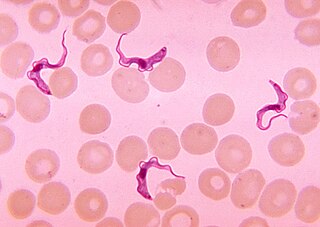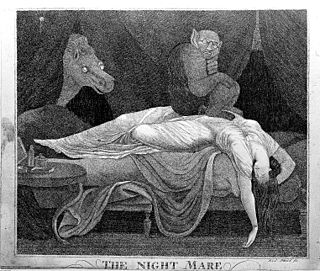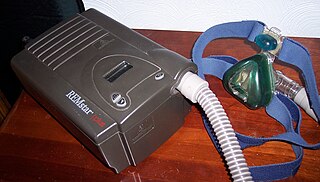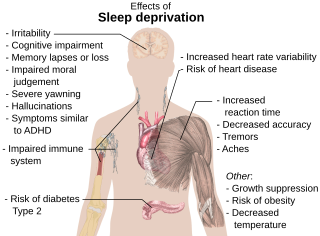 W
WA sleep disorder, or somnipathy, is a medical disorder of the sleep patterns of a person. Some sleep disorders are serious enough to interfere with normal physical, mental, social and emotional functioning. Polysomnography and actigraphy are tests commonly ordered for some sleep disorders.
 W
WAfrican trypanosomiasis, also known as African sleeping sickness or simply sleeping sickness, is an insect-borne parasitic infection of humans and other animals. It is caused by the species Trypanosoma brucei. Humans are infected by two types, Trypanosoma brucei gambiense (TbG) and Trypanosoma brucei rhodesiense (TbR). TbG causes over 98% of reported cases. Both are usually transmitted by the bite of an infected tsetse fly and are most common in rural areas.
 W
WBruxism is excessive teeth grinding or jaw clenching. It is an oral parafunctional activity; i.e., it is unrelated to normal function such as eating or talking. Bruxism is a common behavior; reports of prevalence range from 8% to 31% in the general population. Several symptoms are commonly associated with bruxism, including hypersensitive teeth, aching jaw muscles, headaches, tooth wear, and damage to dental restorations. Symptoms may be minimal, without patient awareness of the condition.
 W
WCentral hypoventilation syndrome (CHS) is a sleep-related breathing disorder that causes ineffective breathing, apnea, or respiratory arrest during sleep. CHS can either be congenital (CCHS) or acquired (ACHS) later in life. The condition can be fatal if untreated. CCHS was once known as Ondine's curse.
 W
WDelayed sleep phase disorder (DSPD), more often known as delayed sleep phase syndrome and also as delayed sleep–wake phase disorder, is a chronic dysregulation of a person's circadian rhythm, compared to those of the general population and societal norms. The disorder affects the timing of sleep, peak period of alertness, the core body temperature, rhythm, hormonal as well as other daily cycles. People with DSPD generally fall asleep some hours after midnight and have difficulty waking up in the morning. People with DSPD probably have a circadian period significantly longer than 24 hours. Depending on the severity, the symptoms can be managed to a greater or lesser degree, but no cure is known, and research suggests a genetic origin for the disorder.
 W
WEmployees who work overtime hours experience numerous mental, physical, and social effects. Significant effects include stress, lack of free time, poor work-life balance, and health risks. Employee performance levels could also be lowered. Long work hours could lead to tiredness, fatigue, and lack of attentiveness. As a result, suggestions have been proposed for risk mitigation.
 W
WFatal insomnia is a rare disorder that results in trouble sleeping. The problems with sleeping typically start out gradually and worsen over time. Other symptoms may include speech problems, coordination problems, and dementia. It results in death within a few months to a few years.
 W
WInsomnia, also known as sleeplessness, is a sleep disorder in which people have trouble sleeping. They may have difficulty falling asleep, or staying asleep as long as desired. Insomnia is typically followed by daytime sleepiness, low energy, irritability, and a depressed mood. It may result in an increased risk of motor vehicle collisions, as well as problems focusing and learning. Insomnia can be short term, lasting for days or weeks, or long term, lasting more than a month.
 W
WThe lateral hypothalamus (LH), also called the lateral hypothalamic area (LHA), contains the primary orexinergic nucleus within the hypothalamus that widely projects throughout the nervous system; this system of neurons mediates an array of cognitive and physical processes, such as promoting feeding behavior and arousal, reducing pain perception, and regulating body temperature, digestive functions, and blood pressure, among many others. Clinically significant disorders that involve dysfunctions of the orexinergic projection system include narcolepsy, motility disorders or functional gastrointestinal disorders involving visceral hypersensitivity, and eating disorders.
 W
WNarcolepsy is a long-term neurological disorder that involves a decreased ability to regulate sleep-wake cycles. Symptoms often include periods of excessive daytime sleepiness and brief involuntary sleep episodes. About 70% of those affected also experience episodes of sudden loss of muscle strength, known as cataplexy. These experiences can be brought on by strong emotions. Less commonly, there may be vivid hallucinations or an inability to move while falling asleep or waking up. People with narcolepsy tend to sleep about the same number of hours per day as people without, but the quality of sleep tends to be lessened.
 W
WThe night hag or old hag is the name given to a supernatural creature, commonly associated with the phenomenon of sleep paralysis. It is a phenomenon during which a person feels a presence of a supernatural malevolent being which immobilizes the person as if sitting on their chest or the foot of their bed. The word "night-mare" or "nightmare" was used to describe this phenomenon before the word received its modern, more general meaning. Various cultures have various names for this phenomenon and/or supernatural character.
 W
WNightmare disorder, also known as dream anxiety disorder, is a sleep disorder characterized by frequent nightmares. The nightmares, which often portray the individual in a situation that jeopardizes their life or personal safety, usually occur during the REM stages of sleep. Though most people have experienced at least one nightmare during their life, subjects with nightmare disorder experience them with a greater frequency. The disorder's DSM-IV number is 307.47.
 W
WNocturnal enuresis, also called bedwetting, is involuntary urination while asleep after the age at which bladder control usually begins. Bedwetting in children and adults can result in emotional stress. Complications can include urinary tract infections.
 W
WObesity hypoventilation syndrome (OHS) is a condition in which severely overweight people fail to breathe rapidly or deeply enough, resulting in low oxygen levels and high blood carbon dioxide (CO2) levels. The syndrome is often associated with obstructive sleep apnea (OSA), which causes periods of absent or reduced breathing in sleep, resulting in many partial awakenings during the night and sleepiness during the day. The disease puts strain on the heart, which may lead to heart failure and leg swelling.
 W
WObstructive sleep apnea (OSA) is the most common sleep-related breathing disorder and is characterized by recurrent episodes of complete or partial obstruction of the upper airway leading to reduced or absent breathing during sleep. These episodes are termed "apneas" with complete or near-complete cessation of breathing, or "hypopneas" when the reduction in breathing is partial. In either case, a fall in blood oxygen saturation, a disruption in sleep, or both may result. A high frequency of apneas or hypopneas during sleep may interfere with restorative sleep, which—in combination with disturbances in blood oxygenation—is thought to contribute to negative consequences to health and quality of life. The terms obstructive sleep apnea syndrome (OSAS) or obstructive sleep apnea–hypopnea syndrome (OSAHS) may be used to refer to OSA when it is associated with symptoms during the daytime.
 W
WRapid eye movement sleep behavior disorder or REM behavior disorder (RBD) is a sleep disorder in which people act out their dreams. It involves abnormal behavior during the sleep phase with rapid eye movement (REM) sleep. The major feature of RBD is loss of muscle atonia during otherwise intact REM sleep. REM sleep is the stage of sleep in which most vivid dreaming occurs. The loss of motor inhibition leads to a wide spectrum of behavioral release during sleep. This extends from simple limb twitches to more complex integrated movement. These behaviors can be violent in nature and in some cases will result in injury to either the individual or their bedmates.
 W
WRestless legs syndrome (RLS) is generally a long-term disorder that causes a strong urge to move one's legs. There is often an unpleasant feeling in the legs that improves somewhat by moving them. This is often described as aching, tingling, or crawling in nature. Occasionally, arms may also be affected. The feelings generally happen when at rest and therefore can make it hard to sleep. Due to the disturbance in sleep, people with RLS may have daytime sleepiness, low energy, irritability and a depressed mood. Additionally, many have limb twitching during sleep.
 W
WShallow breathing, or chest breathing is the drawing of minimal breath into the lungs, usually by drawing air into the chest area using the intercostal muscles rather than throughout the lungs via the diaphragm. Shallow breathing can result in or be symptomatic of rapid breathing and hypoventilation. Most people who breathe shallowly do it throughout the day and are almost always unaware of the condition.
 W
WSleep apnea, also spelled sleep apnoea, is a sleep disorder in which pauses in breathing or periods of shallow breathing during sleep occur more often than normal. Each pause can last for a few seconds to a few minutes and they happen many times a night. In the most common form, this follows loud snoring. There may be a choking or snorting sound as breathing resumes. Because the disorder disrupts normal sleep, those affected may experience sleepiness or feel tired during the day. In children it may cause hyperactivity or problems in school.
 W
WSleep debt or sleep deficit is the cumulative effect of not getting enough sleep. A large sleep debt may lead to mental or physical fatigue.
 W
WA sleep diary is a record of an individual's sleeping and waking times with related information, usually over a period of several weeks. It is self-reported or can be recorded by a care-giver.
 W
WSleep paralysis is a state, during waking up or falling asleep, in which a person is aware but unable to move or speak. During an episode, one may hallucinate, which often results in fear. Episodes generally last less than a couple of minutes. It may occur as a single episode or be recurrent.
 W
WEllen Sadler, sometimes called The Sleeping Girl of Turville, was a resident of Turville, a small village in Buckinghamshire in the United Kingdom. In 1871, aged eleven, she purportedly fell asleep and did not wake for nine years. The case attracted international attention from newspapers, medical professionals and the public.
 W
WSleepwalking, also known as somnambulism or noctambulism, is a phenomenon of combined sleep and wakefulness. It is classified as a sleep disorder belonging to the parasomnia family. It occurs during slow wave sleep stage, in a state of low consciousness, with performance of activities that are usually performed during a state of full consciousness. These activities can be as benign as talking, sitting up in bed, walking to a bathroom, consuming food, and cleaning, or as hazardous as cooking, driving a motor vehicle, violent gestures and grabbing at hallucinated objects.
 W
WSnoring is the vibration of respiratory structures and the resulting sound due to obstructed air movement during breathing while sleeping. In some cases, the sound may be soft, but in most cases, it can be loud and unpleasant. Snoring during sleep may be a sign, or first alarm, of obstructive sleep apnea (OSA). Research suggests that snoring is one of the factors of sleep deprivation.
 W
WSomnology is the scientific study of sleep. It includes clinical study and treatment of sleep disorders and irregularities. Sleep medicine is a subset of somnology.
 W
WSudden Infant Death Syndrome (SIDS), also known as cot death or crib death, is the sudden unexplained death of a child of less than one year of age. Diagnosis requires that the death remain unexplained even after a thorough autopsy and detailed death scene investigation. SIDS usually occurs during sleep. Typically death occurs between the hours of 00:00 and 09:00. There is usually no noise or evidence of struggle. SIDS remains the leading cause of infant mortality in Western countries, contributing to half of all post-neonatal deaths.